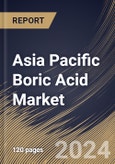The agricultural sector has witnessed a notable adoption of boric acid, driven by the overall shift towards sustainable farming practices. Farmers increasingly recognize the benefits of incorporating boric acid into fertilizers to address soil deficiencies and enhance crop yields. As the agricultural industry embraces environmentally friendly solutions, adopting boric acid is becoming integral to modern farming practices. In consumer-driven industries such as cosmetics and personal care, there is a growing preference for natural and sustainable ingredients. With its mild and natural properties, boric acid has found a place in formulations for skincare, haircare, and other personal care products. The adoption of boric acid in these industries reflects a broader consumer trend towards eco-friendly and ethically sourced products.
Boric acid is a white, crystalline compound with antifungal and antiviral effects. It is used in many industries, including nuclear power, pharmaceuticals, and agriculture. The rising demand for this substance can be attributed to its expanding use in agriculture for micronutrient supplementation and its function in producing flame retardants, glass, and ceramics, which displays an increasing recognition of its versatile properties.
The growing pharmaceutical manufacturing activities in the Asia Pacific region contribute to increased demand for boric acid as an excipient. As the pharmaceutical industry in Asia Pacific expands, there is a corresponding rise in the demand for boric acid for its antimicrobial properties. Therefore, due to the above-mentioned factors, the boric acid market will grow significantly in this region.
The China market dominated the Asia Pacific Boric Acid Market by Country in 2022, and would continue to be a dominant market till 2030; thereby, achieving a market value of $175 Million by 2030. The Japan market is registering a CAGR of 5% during (2023 - 2030). Additionally, The India market would experience a CAGR of 6.3% during (2023 - 2030).
Based on Grade, the market is segmented into Industrial, Pharmaceutical, and Others. Based on End-use, the market is segmented into Construction, Agriculture, Automotive, Electronics, Pharmaceutical & Healthcare, and Other. Based on countries, the market is segmented into China, Japan, India, South Korea, Singapore, Malaysia, and Rest of Asia Pacific.
List of Key Companies Profiled
- Rio Tinto PLC (Rio Tinto Internationals Holdings Limited)
- Rose Mill Co.
- Speed International India Pvt Ltd.
- Avantor, Inc.
- 3M Company
- Minera Santa Rita S.R.L
- Quiborax S.A.
- Gujarat Boron Derivatives Pvt. Ltd
- Eti Maden
- BASF SE
Market Report Segmentation
By Grade (Volume, Killo Tonnes, USD Billion, 2019-2030)- Industrial
- Pharmaceutical
- Others
- Construction
- Agriculture
- Automotive
- Electronics
- Pharmaceutical & Healthcare
- Others
- China
- Japan
- India
- South Korea
- Singapore
- Malaysia
- Rest of Asia Pacific
Table of Contents
Companies Mentioned
- Rio Tinto PLC (Rio Tinto Internationals Holdings Limited)
- Rose Mill Co.
- Speed International India Pvt Ltd.
- Avantor, Inc.
- 3M Company
- Minera Santa Rita S.R.L
- Quiborax S.A.
- Gujarat Boron Derivatives Pvt. Ltd
- Eti Maden
- BASF SE
Methodology

LOADING...








